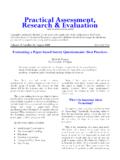Transcription of Background and Health Impacts
1 Page 1 of 9 frequently asked Questions: Respirable Crystalline Silica Rule Background and Health Impacts What is crystalline silica? Crystalline silica is a common mineral found in many naturally occurring materials and used in many industrial products and at construction sites. Materials like sand, concrete, stone and mortar contain crystalline silica. Crystalline silica is also used to make products such as glass, pottery, ceramics, bricks, concrete and artificial stone. Industrial sand used in certain operations, such as foundry work and hydraulic fracturing (fracking), is also a source of crystalline silica exposure. Amorphous silica, such as silica gel, is not crystalline silica. How can exposure to crystalline silica affect workers Health ? Inhaling very small ( respirable ) crystalline silica particles, causes multiple diseases, including silicosis, an incurable lung disease that can lead to disability and death.
2 Respirable crystalline silica also causes lung cancer, chronic obstructive pulmonary disease (COPD), and kidney disease. Who is at risk from exposure to crystalline silica? Around million workers are exposed to crystalline silica on the job. Simply being near sand or other silica-containing materials is not hazardous. The hazard exists when specific activities create respirable dust that is released into the air. Respirable crystalline silica very small particles typically at least 100 times smaller than ordinary sand found on beaches or playgrounds is generated by high-energy operations like cutting, sawing, grinding, drilling and crushing stone, rock, concrete, brick, block and mortar; or when using industrial sand. Activities such as abrasive blasting with sand; sawing brick or concrete; sanding or drilling into concrete walls; grinding mortar; manufacturing brick, concrete blocks, or ceramic products; and cutting or crushing stone generates respirable dust.
3 What is the relationship between silica exposure and lung cancer? There is strong scientific evidence showing that exposure to respirable crystalline silica can increase a person s risk of developing lung cancer. The World Health Organization s International Agency for Research on Cancer the leading international voice on cancer causation and the National Institutes of Health s National Toxicology Program have conducted extensive reviews of the scientific literature and have designated crystalline silica as a known human carcinogen. The American Cancer Society has adopted the WHO and NIH s determinations. More than 50 peer-reviewed epidemiological studies that OSHA evaluated for this rulemaking have examined the link between silica exposure and lung cancer in at least 10 industries. In particular, several studies of workers in specific industrial sectors support the link between exposure to respirable crystalline silica and lung cancer among workers.
4 Page 2 of 9 How will the crystalline silica rule protect workers Health ? The new rule requires that employers use engineering controls such as ventilation and wet methods for cutting and sawing crystalline silica-containing materials to reduce workers exposure to silica dust. Once the full effects of the rule are realized, OSHA expects it to prevent 600 deaths a year from silica-related diseases such as silicosis, lung cancer, other respiratory diseases and kidney disease and to prevent more than 900 new cases of silicosis each year. Need for a Silica Rule Why is OSHA issuing a new crystalline silica rule? OSHA s previous permissible exposure limits (PELs) for silica were outdated, inconsistent and did not adequately protect worker Health . The previous PELs were based on studies from the 1960s and earlier that did not reflect more recent scientific evidence showing that low-level exposures to silica cause serious Health effects, including lung cancer.
5 In the 45 years since the previous PELs were established, the National Toxicology Program, the International Agency for Research on Cancer, and the National Institute for Occupational Safety and Health have all identified respirable crystalline silica as a human carcinogen. Previous construction and shipyard PELs were based on an old method of measuring worker exposures to silica that is not used today. Those previous limits are inconsistent, allowing permissible levels for construction and shipyards to be more than twice as high as levels in general industry. The revised rule will reduce the risk of disease among workers who inhale respirable crystalline silica and provide the same protection for all workers covered. There is evidence of a decline of silicosis cases in recent years. Why is the rule necessary if the silicosis problem in the seems to be going away? Silicosis deaths have declined in recent years but the problem remains serious.
6 From 2005 through 2014, silicosis was listed as the underlying or a contributing cause of death on over 1,100 death certificates in the United States,1 but most deaths from silicosis go undiagnosed and unreported. Also, those numbers of silicosis deaths do not include additional deaths from other silica-related diseases such as COPD, lung cancer and kidney disease. While the number of silicosis cases has declined over the past several decades, it is still a very serious workplace Health problem. In fact, more workers died from silicosis in 2014 than in fires, or from being caught in or crushed by collapsing materials, such as in trench and structure 1 Centers for Disease Control and Prevention, National Center for Health Statistics. Multiple Cause of Death 1999-2014 on CDC WONDER Online Database, released 2015. Data are from the Multiple Cause of Death Files, 1999-2014, as compiled from data provided by the 57 vital statistics jurisdictions through the Vital Statistics Cooperative Program.
7 Accessed at on Mar 7, 2016 2:33:51 PM 2 Bureau of Labor Statistics (2014). Fatal occupational injuries by event or exposure for all fatal injuries and major private industrial sector, all United States, 2014. Page 3 of 9 Unless action is taken, new cases of silicosis could increase as workers are being exposed to respirable crystalline silica in some newer industries such as hydraulic fracturing and artificial stone countertop fabrication. What is the new permissible exposure limit (PEL)? The PEL limits worker exposures to 50 micrograms of respirable crystalline silica per cubic meter of air ( g/m3), averaged over an eight-hour day. This level is the same for all workplaces covered by the standard (general industry/maritime and construction), and is roughly 50 percent of the previous PEL for general industry, and roughly 20 percent of the previous PEL for construction and shipyards. The National Institute for Occupational Safety and Health (NIOSH) first recommended this exposure limit to OSHA over 40 years ago, and the American Public Health Association has also recommended that OSHA adopt this PEL.
8 The American Conference of Governmental Industrial Hygienists recommends an even lower exposure limit of 25 g/m3 of air, averaged over an eight-hour day. OSHA established a PEL of 50 g/m3 because the agency determined that occupational exposure to respirable crystalline silica at the previous PELs resulted in a significant risk of developing or dying from silicosis and dying from lung cancer, other lung diseases, or kidney disease, and that compliance with a 50 g/m3 PEL would substantially reduce that risk. OSHA also finds significant risk remaining at the new PEL, but considers a PEL of 50 g/m3 to be the lowest level that can reasonably be achieved through use of engineering controls and work practices in most affected operations. Impacts on Industry What industries will be affected by the rule? The main industries affected include: Construction Glass manufacturing Pottery products Structural clay products Concrete products Foundries Dental laboratories Paintings and coatings Jewelry production Refractory products Landscaping Ready-mix concrete Cut stone and stone products Abrasive blasting in: o Maritime work o Construction o General industry Refractory furnace installation and repair Railroads Hydraulic fracturing for gas and oil Asphalt products manufacturing Page 4 of 9 How many workplaces will be affected by the rule?
9 Approximately 676,000 workplaces will be affected, including in construction and in general industry and maritime. How many workers will be affected by the rule? About million workers are exposed to respirable crystalline silica in their workplaces. The majority of these workers, about 2 million, are in the construction industry. What is the economic impact of the rule? The rule is estimated to provide average annual net benefits over the next 60 years of $ to $ billion. The total annualized cost of the rule is just over $1 billion dollars. The rule is expected to result in annual costs of about $1,524 for the average workplace covered by the rule. The annual cost to a firm with fewer than twenty employees will be less, averaging about $560. Based on OSHA s analysis, the economic impact of the silica rule on most affected firms, including small businesses, will be minor. Why does the total compliance cost of the rule appear to be so high?
10 The standards for general industry and construction are among the broadest that OSHA has issued, in terms of the number of industry sectors and establishments potentially affected. It potentially affects million workers and 676,000 establishments. The costs are thus spread over a large number of affected establishments and workers. OSHA s economic analysis indicates that the silica rule will not have a significant economic impact on firms, nor a significant effect on jobs due to implementation of the rules. The aggregate costs are more than offset by the potential benefits to society in terms of reduced costs associated with preventing silica-related illnesses and deaths. How will the rule impact jobs? According to a study conducted by Inforum, a well-recognized macroeconomics modeling firm based at the University of Maryland, the rule will have a negligible (but positive) net effect on overall employment. How were small businesses included in design and evaluation of the rule?















